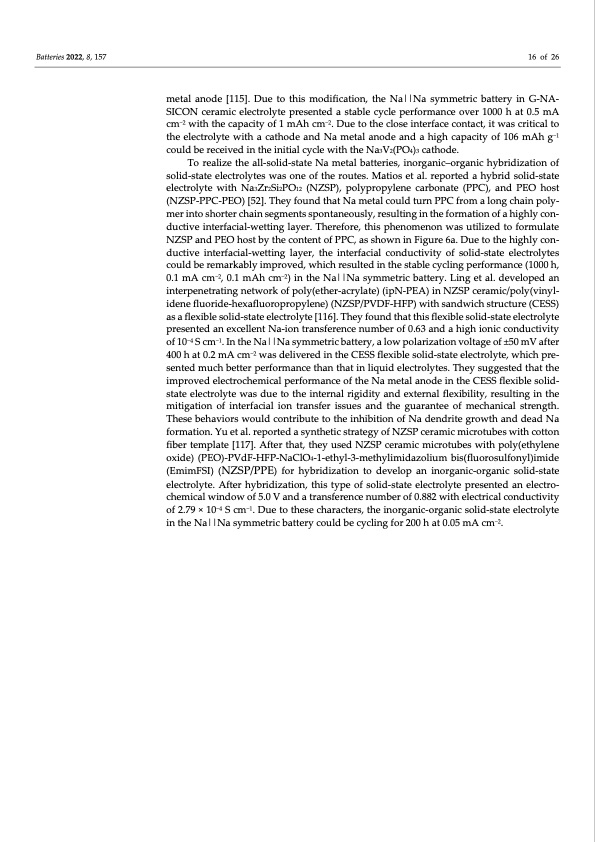
PDF Publication Title:
Text from PDF Page: 016
Batteries 2022, 8, 157 16 of 26 metal anode [115]. Due to this modification, the Na||Na symmetric battery in G‐NA‐ SICON ceramic electrolyte presented a stable cycle performance over 1000 h at 0.5 mA cm−2 with the capacity of 1 mAh cm−2. Due to the close interface contact, it was critical to the electrolyte with a cathode and Na metal anode and a high capacity of 106 mAh g−1 could be received in the initial cycle with the Na3V2(PO4)3 cathode. To realize the all‐solid‐state Na metal batteries, inorganic–organic hybridization of solid‐state electrolytes was one of the routes. Matios et al. reported a hybrid solid‐state electrolyte with Na3Zr2Si2PO12 (NZSP), polypropylene carbonate (PPC), and PEO host (NZSP‐PPC‐PEO) [52]. They found that Na metal could turn PPC from a long chain poly‐ mer into shorter chain segments spontaneously, resulting in the formation of a highly con‐ ductive interfacial‐wetting layer. Therefore, this phenomenon was utilized to formulate NZSP and PEO host by the content of PPC, as shown in Figure 6a. Due to the highly con‐ ductive interfacial‐wetting layer, the interfacial conductivity of solid‐state electrolytes could be remarkably improved, which resulted in the stable cycling performance (1000 h, 0.1 mA cm−2, 0.1 mAh cm−2) in the Na||Na symmetric battery. Ling et al. developed an interpenetrating network of poly(ether‐acrylate) (ipN‐PEA) in NZSP ceramic/poly(vinyl‐ idene fluoride‐hexafluoropropylene) (NZSP/PVDF‐HFP) with sandwich structure (CESS) as a flexible solid‐state electrolyte [116]. They found that this flexible solid‐state electrolyte presented an excellent Na‐ion transference number of 0.63 and a high ionic conductivity of 10−4 S cm−1. In the Na||Na symmetric battery, a low polarization voltage of ±50 mV after 400 h at 0.2 mA cm−2 was delivered in the CESS flexible solid‐state electrolyte, which pre‐ sented much better performance than that in liquid electrolytes. They suggested that the improved electrochemical performance of the Na metal anode in the CESS flexible solid‐ state electrolyte was due to the internal rigidity and external flexibility, resulting in the mitigation of interfacial ion transfer issues and the guarantee of mechanical strength. These behaviors would contribute to the inhibition of Na dendrite growth and dead Na formation. Yu et al. reported a synthetic strategy of NZSP ceramic microtubes with cotton fiber template [117]. After that, they used NZSP ceramic microtubes with poly(ethylene oxide) (PEO)‐PVdF‐HFP‐NaClO4‐1‐ethyl‐3‐methylimidazolium bis(fluorosulfonyl)imide (EmimFSI) (NZSP/PPE) for hybridization to develop an inorganic‐organic solid‐state electrolyte. After hybridization, this type of solid‐state electrolyte presented an electro‐ chemical window of 5.0 V and a transference number of 0.882 with electrical conductivity of 2.79 × 10−4 S cm−1. Due to these characters, the inorganic‐organic solid‐state electrolyte in the Na||Na symmetric battery could be cycling for 200 h at 0.05 mA cm−2.PDF Image | Electrolyte Engineering for Sodium Metal Batteries

PDF Search Title:
Electrolyte Engineering for Sodium Metal BatteriesOriginal File Name Searched:
batteries-08-00157.pdfDIY PDF Search: Google It | Yahoo | Bing
Product and Development Focus for Salgenx
Redox Flow Battery Technology: With the advent of the new USA tax credits for producing and selling batteries ($35/kW) we are focussing on a simple flow battery using shipping containers as the modular electrolyte storage units with tax credits up to $140,000 per system. Our main focus is on the salt battery. This battery can be used for both thermal and electrical storage applications. We call it the Cogeneration Battery or Cogen Battery. One project is converting salt (brine) based water conditioners to simultaneously produce power. In addition, there are many opportunities to extract Lithium from brine (salt lakes, groundwater, and producer water).Salt water or brine are huge sources for lithium. Most of the worlds lithium is acquired from a brine source. It's even in seawater in a low concentration. Brine is also a byproduct of huge powerplants, which can now use that as an electrolyte and a huge flow battery (which allows storage at the source).We welcome any business and equipment inquiries, as well as licensing our flow battery manufacturing.| CONTACT TEL: 608-238-6001 Email: greg@salgenx.com | RSS | AMP |